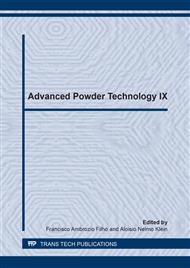p.245
p.250
p.256
p.262
p.268
p.274
p.280
p.285
p.291
Study of the Use of an Anionic Collector in the Mineral Wastewater Treatment by Dissolved Air Flotation
Abstract:
The use of recycled water in the apatite flotation may result in losses to the process performance due to the presence of ions, residual reagents, finely particulate material, etc. The dissolved air flotation (DAF) has been shown an efficient technique in the wastewater treatment in the removal of these pollutants. The use of anionic collector in DAF process is based on the reaction that occurs between the soybean oil soap (apatite collector) with the calcium present in the apatite lattice making its surface hydrophobic. Therefore, the collector can be an auxiliary in the water softening besides improving the hydrophobicity of the particles to be collected. Thus, this study was aimed at evaluating the effect of an anionic collector used as an auxiliary in the dissolved air flotation process. A central composite design (CCD) was proposed to evaluate the concentration of collector and the effect of pH value on the removal efficiency of calcium, magnesium, fluoride, phosphorous and turbidity present in a wastewater from a fertilizer industry. The results showed a good removal of the contaminants which guaranteed a better quality of water to the process of phosphate rock concentration.
Info:
Periodical:
Pages:
268-273
Citation:
Online since:
December 2014
Authors:
Price:
Сopyright:
© 2014 Trans Tech Publications Ltd. All Rights Reserved
Share:
Citation:


